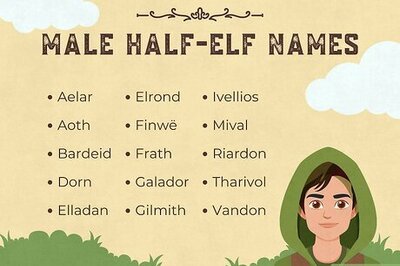
views
The seven (or ten) days that Swami Vivekananda spent with Bal Gangadhar Tilak at the latter’s residence in Pune in September 1892 did not shake the world. While Vivekananda was then a relatively unknown and ambulant monk from Bengal, Tilak ran law tutorials from his residence and was the rising star of the orthodox camp in Pune but far from being a national leader. Vivekananda’s advent did catch the eye of the Pune society, but he departed too soon, apparently without taking formal leave from the host. Little did Vivekananda and Tilak know what destiny had in store for them within a span of twelve months.
Their feats would make them the cynosure of all eyes and help Hindu society regain its self-confidence undermined by the nineteenth-century reformist campaign. Though separated by a distance of more than 13,000 km, their acts coincided in time. While Vivekananda’s impromptu speech at the Parliament of Religion in Chicago on September 11, 1893, filled Hindus with pride, the first edition of Tilak’s Ganesh Utsav at Pune, which lasted from September 14 to 24, became a major success and trendsetter. It spread out to all parts of Maharashtra (and Maratha princely states) within a few years. It provided the model for Sarbojonin Durga Puja in Bengal during the first decade of the 20th century. More than a century and a quarter later, Ganesh Utsav is celebrated in various parts of India. It would be apposite to examine these two events in their historical context, even as the annual Ganesh Utsav is currently on.
It was the reformists, ranging from Raja Ram Mohun Roy (1772-1833) to Justice Mahadev Govind Ranade (1842-1901), who pioneered the growth of public opinion and culture in the 19th century. They believed in enlightened cooperation with British rule, which offered prospects for constitutional reforms. The reformists were not footloose when it came to religion and culture. Nor did they condone the ingress of Christian proselytism in the Hindu society. Rather, they wished to prove that Hinduism was a repository of superior philosophic thought as embodied in the Vedas and the Upanishads.
Roy, by translating the Upanishads into English, Bengali and Hindi, and publishing them by taking advantage of the nascent printing press technology, put into public domain what was in the custody of the few. Such was the state of the Hindu scholarship then, that people hardly knew anything about the Upanishads in Bengal. Roy was accused of forgery by Sanskrit scholars, who were mostly trained in Nyaya-Vaisheshika, Jyotish, and Hindu law. They alleged Roy was passing off his own writings in the name of ancient sages. Roy set up Atmiya Sabha and Brahmo Sabha (later Brahmo Samaj) which promoted the worship of the formless divine.
The reformists should no doubt be complimented for going to the foundation of Hindu philosophical thought, thus challenging the status quo in Hindu society. However, their approach suffered from several lacunae as well. They considered themselves on the right, and the rest of Hindu society as deviant. This deviation, to them, was the result of historical degeneration when the Hindu society abandoned the worship of the formless divine and espoused polytheism under the impact of the Puranas. Saying that the vast majority of the Hindu society lived in fatal error was akin to affirming, as Christian missionaries often did, that heathens lived in sin.
The reformists represented the advanced section of society. They were the elites of opinion-making, with whom the rest of the society could hardly compete. The number of authors, scientists, doctors and jurists that Brahmo Samaj produced in Bengal is disproportionate to their membership strength. They as though forced the rest of the Hindu society to live in guilt.
It would be wrong to keep only the ‘Westernised’ elites in the category of reformers. They are nowadays unfairly labelled as pseudo-Christians for their love of British politics, and opposition to image worship. The Arya Samaj, founded by Swami Dayananda, who did not know a word of English, or at any rate could not be accused of Christian influence, was a more militant opponent of image worship among the Hindus.
Arya Samaj viewed the evolution of Hindu society subsequent to the Vedic era as degeneration. Thus Arya Samaj, while it reinvigorated the Hindu society in one sense, deepened the guilty conscience about image worship in another sense. In Maharashtra, Prarthana Samaj, with which Justice M.G. Ranade and antiquarian R.G. Bhandarkar were associated, was the best-known agency of the reformists.
II
The person who broke this stranglehold of ‘guilty conscience’ about image worship was Sri Ramakrishna Paramhansa (1836-86). He did so with the example of his own life, full of devotion and piety, rather than any scholarly disputation. He put realisation or direct perception of the divine at the heart of religious life. He espoused the devotion of the divine with form and without form, and declared that all paths to divinity are true. Keshub Chandra Sen (1838-1884), a leading figure of the Brahmo Samaj, gravitated towards Ramakrishna’s path of devotion.
Swami Vivekananda (1863-1902) was Ramakrishna’s foremost disciple. With a background in English education and knowledge of Western philosophy, he dived deep into spiritual pursuits. Having espoused a life of monkhood with fellow disciples of Ramakrishna, he travelled all over India in the early 1890s, obtaining firsthand knowledge about the condition of the country. Vivekananda’s spiritual and mundane experiences convinced him about the profundity of Indian thought. He could see India’s fundamental greatness despite the poverty, misery, squalor and skullduggery.
His finest hour came on September 11, 1893, at the Parliament of World Religions in Chicago. Though he was not invited as a delegate as some other publicists from India, like Protap Chunder Mozoomdar (Brahmoism) and Virchand R. Gandhi (Jainism), he was permitted to address the audience. His lecture, which unforgettably began with the sentence ‘Sisters and Brothers of America’, contained a refrain – “I am proud”!
“I am proud to belong to a religion which has taught the world both tolerance and universal acceptance. We believe not only in universal tolerance, but we accept all religions as true. I am proud to belong to a nation which has sheltered the persecuted and refugees of all religions and all nations of the earth. I am proud to tell you that we have gathered in our bosom the purest remnant of the Israelites, who came to Southern India and took refuge with us in the very year their holy temple was shattered and is still fostering the remnant of grand Zoroastrian nation.”
The Indians, the Hindus in particular, had reason to be proud based on their track record. The reformists had thus far convinced Hindus that they were living in error. This sense of pride, an intrinsic psychological need, filled Hindus with a sense of self-confidence. Vivekananda’s photo from the Parliament of Religions shows him striking a confident pose with locked arms and a full-blown chest. It symbolised the repositioning of the Hindus in a global perspective. Vivekananda introduced Vedanta and Yoga in the US. The Parliament of World Religions, 1893 thus acted as an entrepôt for Indian spiritual heritage.
III
Three days after Vivekananda’s historic speech, it was Ganesh Chaturthi (Vinayak Chaturthi) on September 14, 1893. Though the auspicious occasion was celebrated in every Marathi home, extending from one and a half days to ten days, Tilak gave it a public character that year.
Tilak’s biographer Ram Gopal (1956) informs that the background to the Ganesh Utsav was provided by a Hindu-Muslim riot in Bombay (now Mumbai) in August 1893. The riot, which was more dangerous than the previous 1873 Parsi-Muslim riot in Bombay, cast its long shadow on Pune. The terror-stricken Hindus flocked to Tilak, arguing that they expected little protection from the government, and imploring that the most fearless leader of Maharashtra should take up their cause (Lokamanya Tilak: A Biography, P.84).
Though the Hindu-Muslim riots in August 1893 must have been the immediate cause, it appears unconvincing that Tilak must have devised his grand plan of Ganesh Utsav merely within one month. He must have been thinking about the matter for quite some time.
His biographer D.V. Tahmankar informs that Tilak, from his study of ancient Greek history, was impressed by the example of the Olympic Games, which had developed into a great nationalist festival, which built up a national spirit among many independent states of Greece. The ancient Olympics, as Tahmankar correctly observes, was a religious festival in honour of god Jupiter held in the plain of Olympia, with sacrifices, processions, and games, with poets and authors reciting their compositions and artists displaying their works (Lokamanya Tilak: Father of Indian Unrest and Maker of Modern India, P.60-61).
Tilak’s other biographer T.V. Parvate (1958) informs that the central India Maratha princes like the Scindias, Holkars, Gaekwads, Pawar and Bhonsles, the Deccan chiefs, and Sardars and Inamdars scattered all over Maharashtra have been celebrating the Ganesh festival with great pomp and pageantry. It was not possible to exactly reproduce the aristocratic splendour and grandeur in Tilak’s democratic festival. Yet, that was more than made up through programmes that promoted intellectual, moral and cultural growth. The Ganesh festival became a kind of a series of extension lectures on various topics and opportunities for the study or re-reading of Hindu religious books like Vedas, the Brahmanas, the Upanishads, the Ramayana and the Mahabharata and the works of saints and saviours. Tilak and his associates turned the Ganesh festival into a national and democratic movement for the intellectual, cultural and artistic uplift of the people (Bal Gangadhar Tilak, P.116).
The Ganesh Utsav allowed ordinary Hindus of Maharashtra to espouse their religion and culture without being on the defensive vis-a-vis Prathana Samaj. That was the reason the festival soon spread out of Pune, to the entire Maharashtra and beyond. Whether it was the Chicago Speech or Ganesh Utsav, it proved that the Hindu sense of unity was essentially creative and constructive rather than predatory and invasive. This is indeed a takeaway that continues to be true even in the 21st century.
The writer is author of the book ‘The Microphone Men: How Orators Created a Modern India’ (2019) and an independent researcher based in New Delhi. Views expressed in the above piece are personal and solely those of the author. They do not necessarily reflect News18’s views.


















Comments
0 comment